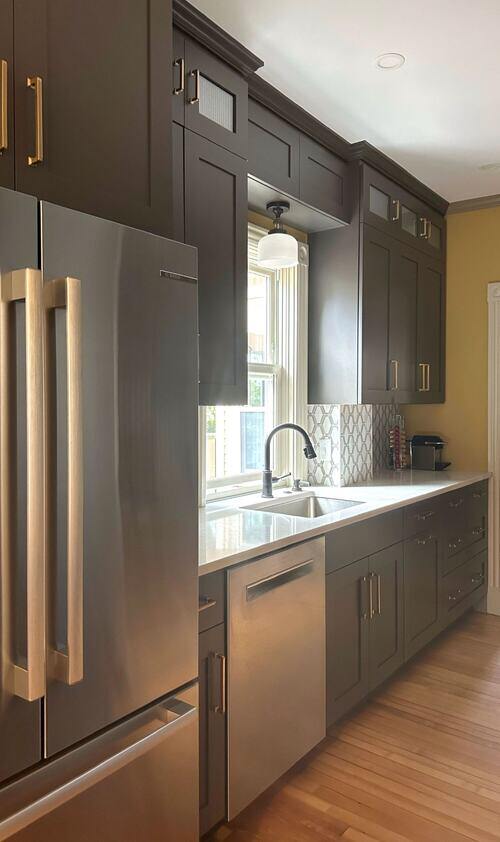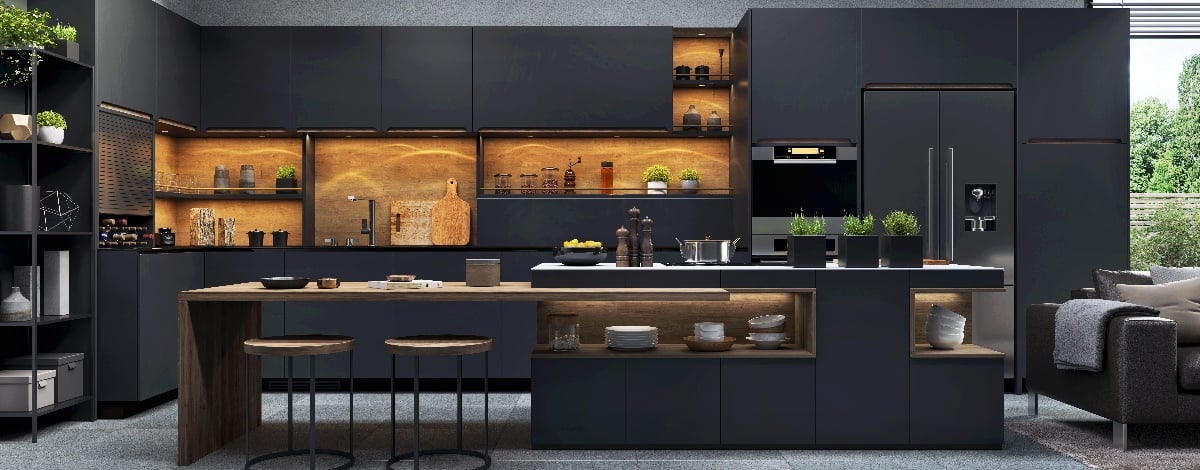Renovating your kitchen is a big project. You'll be pulling materials out and rebuilding whole new aspects of the kitchen, whether you're retiling the backsplash or fully constructing the cabinets.
One of the best things you can do with your kitchen redesign is to go green. Eco-friendly materials and construction choices can significantly reduce both the environmental impact of your project and the toxins inside your house.
Sustainable kitchen choices are also a hot trend this year, in part because technology has made it possible to build an eco-friendly kitchen in so many ways.
Let's explore the many possibilities for your low-footprint and sustainably designed kitchen remodel.
Eco-Friendly Cabinet Remodel Options
- Sustainable Fast-Growing Woods
- Locally Sourced Cabinets
- Pressed Board with No VOCs (Formaldehyde-Free)
- Refinishing Existing Cabinets or Changing Doors-Only
Sustainable cabinet design can be done in so many ways. If you are rebuilding your cabinets, try woods that regrow quickly like bamboo or lyptus which don't require new land to be cut. Sourcing locally means reducing the fuel and therefore carbon footprint of your remodel project.
To reduce toxins in your home and in the environment, source cabinet boards that were pressed with no VOCs, where formaldehyde was not used in the process.
Or, you can minimize your cabinet changes by repainting/refinishing with non-toxic paints or only changing the cabinet doors, not the entire structure.
Green Counter and Tile Ideas
- Reclaimed Tile Backsplashes
- Sealed Concrete or Quartz Counters
The countertops and tile backsplashes in your kitchen are beautiful decorative centerpieces as well as being essential to the kitchen's functional design. They can also be sourced in a number of ways.
Reclaimed tile has been removed from another home or commercial building and is being reused after a little polishing. Remnant stone is countertop stone like granite or marble but in smaller pieces.
It's often leftover slab pieces after a project was cut away or reclaimed broken pieces from a past countertop. They can be beautiful when fit together in a countertop mosaic or cut into smaller counter sections.
You can also choose manufactured or poured countertops made locally from, say, concrete or quartz to reduce the ecological impact of mining. If your counter is lovely but damaged, have the top layer shaved and re-finished.
Sustainable Fixtures and Appliances
- Energy-Efficient Appliances
- Restored or Recycled Fixtures
- Repanel Instead of Replacing
- Access Points for Appliance Maintenance
- Natural Light
Your appliances, lights, and plumbing can all be designed and installed in sustainable ways. Choose efficient fixtures and appliances to use the least electricity and water for each hour of use. Light fixtures and sink fixtures can be restored or recycled from older metals and sourced locally to reduce their impact.
For old but still functional appliances, repanel their doors instead of replacing the whole unit. And think ahead, leave yourself access panels in the cabinetry to make maintenance easier in the future.
You can also reduce your need for electric light by maximizing natural light in the kitchen. Skylights or mirrors that reflect the window light can both provide lovely sunshine during the day.
Walls and Floors
- Reclaimed Wood Panel and Tile
- Engineered Laminate Board Floors
- Green Drywall Board
Going deep with your remodel? If you are reflooring or even rebuilding the walls around your kitchen, there are eco-friendly options here as well. Flooring can be laid from reclaimed wood panels or tile for a floor that comes with a story.
Engineered wood (laminate board) floors are water- and scratch-resistant, low-impact, and not so cold on a winter morning. If you're rebuilding drywall, choose a green board that is both non-toxic and mold-resistant.
Planning for Green Cooking
- Compost Disposal for Gardening
- Tupperware Storage for Leftovers and Ingredients
- Recycling Bin Hutch
- Hooks and Shelves for Kitchen Plants
- Windows and Fans for Fresh Air
Last but not least, plan your green kitchen remodel for future green cooking and recycling choices. Build yourself a special drain or bin for compost and boil-water for the garden.
Give yourself special storage for Tupperware to optimize your ability to save and re-use ingredients. Build a hutch for your recycling bins to make recycling elegant and easy.
Give yourself places to mount plants growing near the kitchen window, and don't forget to make sure that the window opens for a quick efficient kitchen air-out in case of smoke, gas, or heat buildup.
An eco-friendly kitchen redesign has so many options. You can design the kitchen of your dreams, reduce the impact of your project, and plan ahead for fun and elegant green cooking practices all in a single sustainable kitchen remodel. Contact us today to consult on your green kitchen design!











